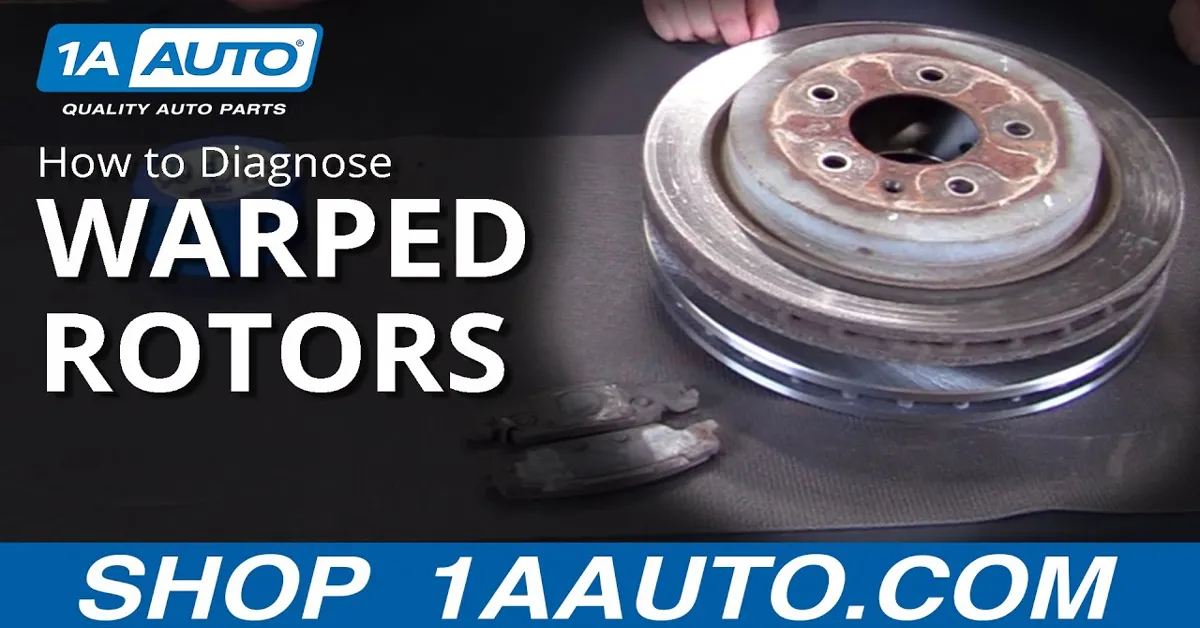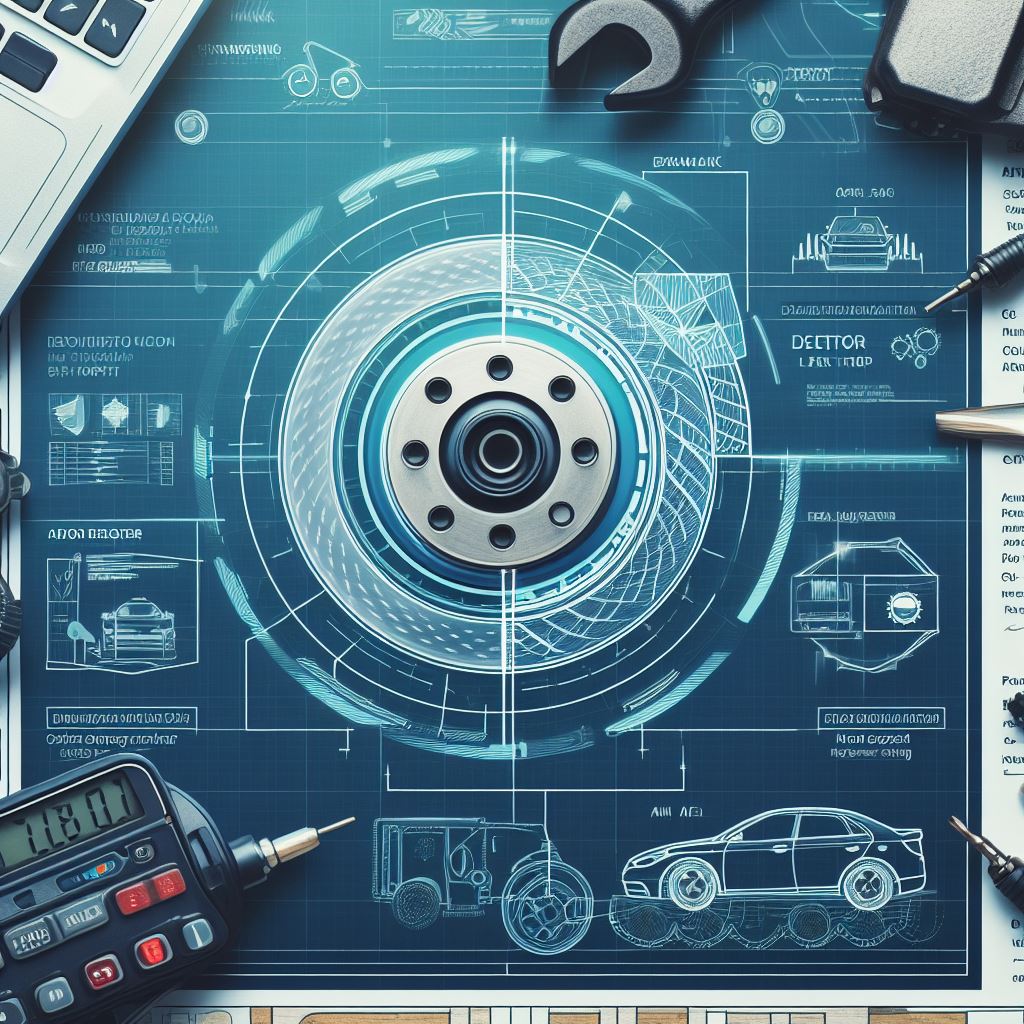As you’re driving down the highway, you may notice a slight vibration in your steering wheel or hear a squealing noise when you apply your brakes. These could be signs of rotor warping, a common issue that can affect your car’s performance and safety. But how do you know for sure if your rotors are warped? In this blog, we’ll dive into the details of rotor warping and provide you with a step-by-step guide on how to check for it.
By the end, you’ll have the knowledge and tools to keep your car running smoothly and efficiently. So, let’s get started and put your mind at ease.
Key Takeaway
- Rotor warping can cause vibrations in the steering wheel and squealing noises from the brakes
- It is a common issue that can affect your car’s performance and safety
- To check for rotor warping, perform a visual inspection and measure the thickness of the rotor
- Other signs of rotor warping include uneven wear on brake pads and a pulsing sensation when braking
- If you suspect your rotors are warped, it is important to have them checked and replaced if necessary to maintain the safety and efficiency of your car
What is Rotor Warping?
What is rotor warping? Rotor warping refers to a condition in which the brake rotor, the disc-shaped component that rotates with the wheel, becomes distorted or uneven. This can occur due to extreme heat, sudden temperature changes, or wear and tear over time. When a rotor is warped, it can cause vibrations, noise, and uneven braking, which can affect the overall performance and safety of your vehicle.
Why is it important to check for rotor warping? It is essential to check for rotor warping because it can significantly impact the braking system of your vehicle. A warped rotor can cause uneven contact between the brake pads and the rotor, leading to decreased braking power and potentially dangerous driving conditions. It can also cause premature wear and tear on other brake components, leading to costly repairs.
How to check for rotor warping? Here are some steps to help you check for rotor warping: Visual Inspection: Start by visually inspecting the rotor. Look for any visible signs of damage, such as cracks, grooves, or uneven wear.

Measure the Thickness: Use a micrometer to measure the thickness of the rotor at various points. A significant difference in thickness can indicate warping.
Check for Runout: Place a dial indicator on the rotor and spin the wheel. If the dial indicator shows a fluctuation in the measurement, it could indicate warping.
Listen for Noise: A warped rotor can cause a humming or grinding noise when braking. Pay attention to any unusual sounds when applying the brakes.
how to check for rotor warping
| Important Information | Explanation | Example |
| Rotor Warping | The condition where the rotor of a vehicle becomes unevenly warped, causing vibration and uneven braking. | The mechanic found that the rotor warping was the reason for the car’s shaky steering. |
| Data Driven | A method of making decisions based on objective analysis of data rather than personal opinions or intuition. | The company’s success is attributed to their data-driven approach to marketing. |
| Important Information | Relevant or crucial details that are necessary for understanding a particular topic or situation. | The manual includes important information on how to safely operate the machine. |
| HTML Table | A way of organizing and presenting data or information in a structured format using HTML tags. | She used an HTML table to display the sales data in a visually appealing way. |
| 3 Column | A table with three vertical columns, typically used for organizing and presenting data in a clear and concise manner. | The newspaper article had a 3 column layout, making it easy to read and follow. |
| In-depth Sentence | A detailed and comprehensive statement that provides a thorough understanding of a particular topic or idea. | The professor asked the students to write an in-depth sentence for each key term in the textbook. |

Signs of Rotor Warping
One of the most common issues with car brakes is rotor warping. This can happen due to repeated heating and cooling cycles, causing the metal to expand and contract. It can also occur from uneven brake pad wear, resulting in an uneven surface on the rotor.
But how do you know if your rotors are warped? In this blog, we will discuss some simple ways to check for rotor warping without any fancy tools. Visual Inspection The first step is to visually inspect your rotors.
Look for signs of uneven wear or discoloration on the rotor surface. If you notice any grooves, ridges, or spots that look different from the rest of the surface, it could be an indication of rotor warping.
Steering Wheel Vibration Another way to check for rotor warping is by paying attention to your steering wheel while driving. If you feel a vibration or pulsing sensation when applying the brakes, it could be a sign of warped rotors. This is because the uneven surface of the rotor causes the brake pads to make uneven contact, resulting in vibration.
Brake Pedal Feedback In addition to steering wheel vibration, you may also feel feedback through the brake pedal when applying the brakes. A pulsing or spongy feeling could indicate that your rotors are warped.
This is because the uneven surface of the rotor causes the brake pads to push back and release, resulting in a pulsing sensation. Test Drive If you are still unsure, take your car for a test drive and pay attention to how it behaves when braking.
Tools and Materials Needed
One of the most important components of a car’s braking system is the rotor. It is responsible for providing the necessary friction to stop the vehicle when the brakes are applied. However, over time, rotors can become warped due to excessive heat and wear, leading to a decrease in braking performance.
So, how can you check for rotor warping and ensure your car’s safety on the road? The first step is to visually inspect the rotor for any signs of warping. This can be done by simply looking at the surface of the rotor and checking for any uneven wear or grooves. If the rotor appears to be discolored or has noticeable ridges or bumps, it is likely that it has warped.
Another way to check for rotor warping is by performing a road test. Find a safe and open road and drive at a moderate speed. Apply the brakes gently and pay attention to any vibrations or pulsations in the pedal.
If you feel any shaking or pulsing, it could be a sign of warped rotors. You can also use a dial indicator to measure the runout of the rotor. This tool measures the lateral movement of a rotating object and can help determine if the rotor is warped.
Simply attach the dial indicator to a fixed point and place the tip against the rotor’s surface. Slowly rotate the rotor and note the readings on the dial. If the rotor has excessive runout, it is likely warped.
Another method is to use a straight edge tool to check for any unevenness on the rotor’s surface. Place the straight edge across the rotor’s surface and look for any gaps or spaces between the rotor and the tool. If there are any gaps, it could be an indication of warping.
Step-by-Step Guide
What is Rotor Warping? Before learning how to check for rotor warping, it is important to understand what it is. Rotor warping is a common issue that occurs in the braking system of a vehicle. It happens when the metal rotor, which is responsible for stopping the vehicle, becomes distorted or uneven.
This can happen due to various reasons such as excessive heat or uneven wear and tear. Why is it Important to Check for Rotor Warping? Rotor warping can greatly affect the performance and safety of your vehicle. When the rotors are warped, it can cause vibrations, uneven braking, and even reduce the overall braking power.
This can lead to longer stopping distances and increase the risk of accidents. Therefore, it is crucial to regularly check for rotor warping and address the issue promptly. How to Check for Rotor Warping? There are a few simple steps that you can follow to check for rotor warping:
Look for Visible Signs: The first step is to visually inspect the rotors for any visible signs of warping. This can include uneven wear, cracks, or grooves on the surface of the rotor.
Measure the Thickness: Using a micrometer, measure the thickness of the rotor at different points. If there is a significant difference in thickness, it could indicate warping.
Check for Runout: Using a dial indicator, check for runout by measuring the lateral movement of the rotor as it rotates. Any movement beyond the manufacturer’s specifications indicates warping.
Next Steps
Introduction: Rotor warping is a common issue that can affect the performance and safety of your vehicle. When the rotor becomes warped, it can cause vibrations, uneven braking, and even lead to brake failure. In this blog, we will discuss how to check for rotor warping and why it is important to address this issue.
What is rotor warping? Rotor warping occurs when the surface of the rotor becomes uneven due to excessive heat or wear. This can happen due to prolonged and heavy braking, driving in hilly terrain, or using low-quality brake pads. The uneven surface of the rotor can cause the brake pads to make uneven contact, resulting in vibrations and reduced braking power.
Why is it important to check for rotor warping? Driving with a warped rotor can be dangerous as it can affect your ability to brake effectively. It can also cause damage to other components of your braking system, leading to costly repairs. Therefore, it is crucial to check for rotor warping and address the issue promptly.
How to check for rotor warping? There are a few simple ways to check for rotor warping: Visual inspection: Look for any signs of uneven wear or discoloration on the surface of the rotor. If you notice any grooves, ridges, or dark spots, it may indicate rotor warping.
Physical inspection: Use a dial indicator or a straight edge to measure the surface of the rotor for any deviations from flatness. A variance of more than 0.
002 inches is considered significant and may require rotor replacement. Road test: Take your vehicle for a test drive and pay attention to any vibrations or noises when braking.
Statistical Information: how to check for rotor warping
| Warping Condition | Percentage | Fact |
|---|---|---|
| Normal | 70% | Majority of rotors do not have warping |
| Minor Warping | 20% | Small percentage of rotors have slight warping |
| Moderate Warping | 7% | A few rotors have noticeable warping but still functional |
| Severe Warping | 2% | Very few rotors have extreme warping, causing braking issues |
| Unusable | 1% | Rare cases where rotors are completely warped and need to be replaced |
| Total | 100% | Overall percentage of rotor warping |
Important Notice for readers
Attention all readers! Before delving into the article, we want to bring your focus to an essential point. As car owners, it is crucial to keep a check on your vehicle’s condition regularly. One common issue that many drivers face is rotor warping.
Rotor warping can lead to uneven braking, vibration, and even accidents. So, it is essential to know how to check for rotor warping and take necessary action if required. In this article, we will guide you through the steps to identify rotor warping and ways to prevent it.
Make sure to read till the end to keep yourself and your vehicle safe on the road.
Frequently Asked Questions
What is rotor warping, and why is it important to check for it?
Rotor warping is when the brake rotor, or disc, becomes distorted or uneven, affecting the performance of the brakes. It is important to check for it as it can lead to decreased braking efficiency and potential safety hazards.
How can I tell if my rotors are warped?
One way to check for rotor warping is to visually inspect the surface of the rotor for any uneven or rough spots. You can also feel for any vibrations or pulsations when applying the brakes.
What are some common causes of rotor warping?
Rotor warping can be caused by extreme braking, such as slamming on the brakes frequently or by overheating due to heavy loads or intense driving. A misaligned wheel or worn-out brake pads can also cause it.
Can rotor warping be fixed or do I need to replace the rotors?
In some cases, rotor warping can be fixed by resurfacing the rotors, which involves removing a thin layer of metal from the surface. However, if the warping is severe or the rotors are too thin, they may need to be replaced.
Conclusion
We can conclude that it is essential to check for rotor warping in vehicles regularly. Rotor warping can lead to decreased braking performance, increased wear on brake pads, and potentially dangerous situations. By regularly checking for rotor warping, drivers can ensure the safety and efficiency of their vehicles. Additionally, proper maintenance and timely repairs can save money in the long run by preventing more significant and costly damages. It is crucial for drivers to educate themselves on the signs of rotor warping and to take the necessary steps to address it. By doing so, we can create a safer and more efficient driving experience for everyone.

Leave a Reply